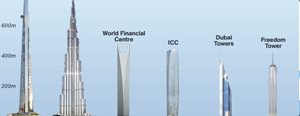 Photo Courtesy: Nicolas Lannuzel The Burj Khalifa in Dubai. Has been the tallest building in the world since 2010 and is classified as 'Megatall'.
Photo Courtesy: Nicolas Lannuzel The Burj Khalifa in Dubai. Has been the tallest building in the world since 2010 and is classified as 'Megatall'.
All across the world we are seeing buildings reach further and further into the earth’s atmosphere in what seems to be a race for the sky supremacy between emerging economic powers.
Four years ago, the Burj Khalifa was completed in Dubai, becoming the world’s tallest building by a substantial margin at the time, beating the previous record holder, Taipei 101 in Taiwan by more than 300 m.
The Burj Khalifa stands at a whopping 829 m above the desert. Standing so high in fact that the cool air from the high-altitude is able to feed and ease the load on its massive air conditioning units.
With the Burj Khalifa so tall and other countries planning to go even further above the clouds, it begs the question: How high can these buildings actually go? Some designers believe that a mile-high building will eventually be built in the very near future.
However, in building toward the moon, immense engineering challenges are presented.
For one, nobody wants to be hiking up 150 flights of stairs to get to their room or office. Basically, this is out of the question, which means that the need for elevators is great. And with a building so tall being able to accommodate a vast populous, there needs to be many elevators to be working with great efficiency in order to keep that populous moving to their destination.
A large portion of the interior volume of these super-high skyscrapers needs to be set aside for elevator banks, which takes away from floor space that could be used in another capacity.
For instance, leading up to beginning the construction of the Kingdom Tower Skyscraper in Saudi Arabia, the elevators were a substantial concern for the designers and engineers. The half-mile building currently under construction will need room for a total of 65 elevators moving at speeds over 10 meters per-second or 750 meters per-minute – quite a good clip.
This isn’t the fastest elevator in the world, as the Taipei 101 has the fastest, moving at 1010 meters per minute or 37.7 miles per hour; however, engineers for the Kingdom Tower are hoping the double-decker elevators and technology, such as calling for an elevator while en route, will lessen the wait times for people using the building.
Will this be successful? Only time will tell. Still, elevators will continue to be a huge issue for engineers to deal with as buildings get taller and taller.






